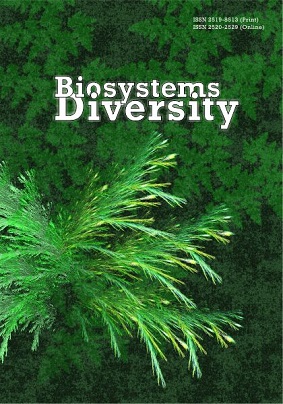Patterns of mercury accumulation in the organs of bank vole Myodes glareolus (Rodentia, Cricetidae)
Patterns of mercury accumulation in the organs of bank vole Myodes glareolus (Rodentia, Cricetidae)
Author(s): V. A. Gremyachikh, D. A. Kvasov, E. S. IvanovaSubject(s): Geography, Regional studies, Energy and Environmental Studies, Human Ecology, Environmental interactions
Published by: Дніпропетровський національний університет імені Олеся Гончара
Keywords: terrestrial ecosystems pollution; heavy metals; mercury; small mammals; rodents;
Summary/Abstract: Mercury (Hg) and its compounds are among the most hazardous environmental pollutants with a high cumulative potential and they can have toxic effects on human and animal health even in low concentrations. Due to the increasing rate of human economic activity and the increase in the amount of Hg in the total cycling of matter, the study of its distribution, transformation, redistribution and accumulation in the abiotic and biotic components of various ecosystems remains important up to the present time. We assessed the content of metal in organs and tissues of the bank vole Myodes(Clethrionomys) glareolus Schreber, 1780 (Rodentia, Cricetidae), a widespread small rodent, caught in different biotopes of forest-steppe and steppe zones of Voronezh region. Measurements of Hg in samples were carried out with a mercury analyzer RA-915+ with the accessory PYRO (Lumex) using the atomic absorption method of cold steam without preliminary sample preparation (the lower limit of mercury detection in samples was 0.001 mg/kg). The sample size was 344 specimens. Mean Hg concentrations ranged from values below the analytical determination threshold to 0.887 mg/kg dry weight in the kidneys, 0.411 in the liver, 0.031 in the muscle tissue, and 0.040 in the brain. A positive correlation was found between the metal content in all possible pairs of organs (except for the “muscle – brain” pair) and a weak negative correlation was found between the Hg level and the mass of the animals. Hg concentrations in the studied organs did not differ between males and females. The metal content in the liver and kidneys of voles from the forest-steppe zone was significantly higher than in those from the steppe zone. Among all studied biotopes (meadow, pine and mixed forest, shrub thickets), the lowest concentrations were observed in animals living in pine forests, while the highest one – in more humidified bush thickets. During the vegetation season, there was a decrease in the average values of animal body mass in the samples and an increase in the content of Hg in the liver and kidneys. The results of the study are relevant in the assessment of atmospheric mercury pollution of terrestrial ecosystems using small mammals, such as Myodes glareolus, as a model object.
Journal: Biosystems Diversity
- Issue Year: 27/2019
- Issue No: 4
- Page Range: 329-333
- Page Count: 5
- Language: English

